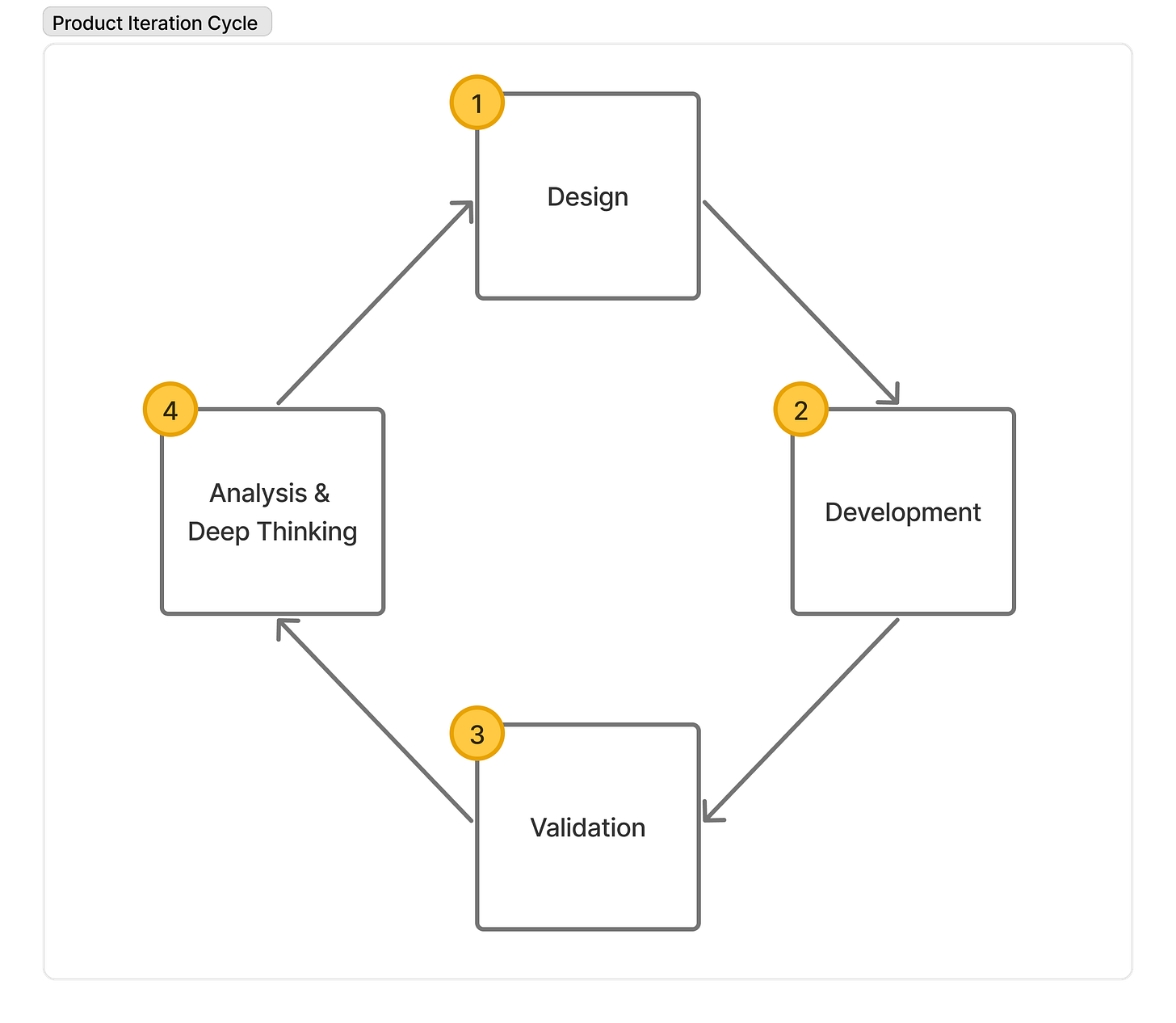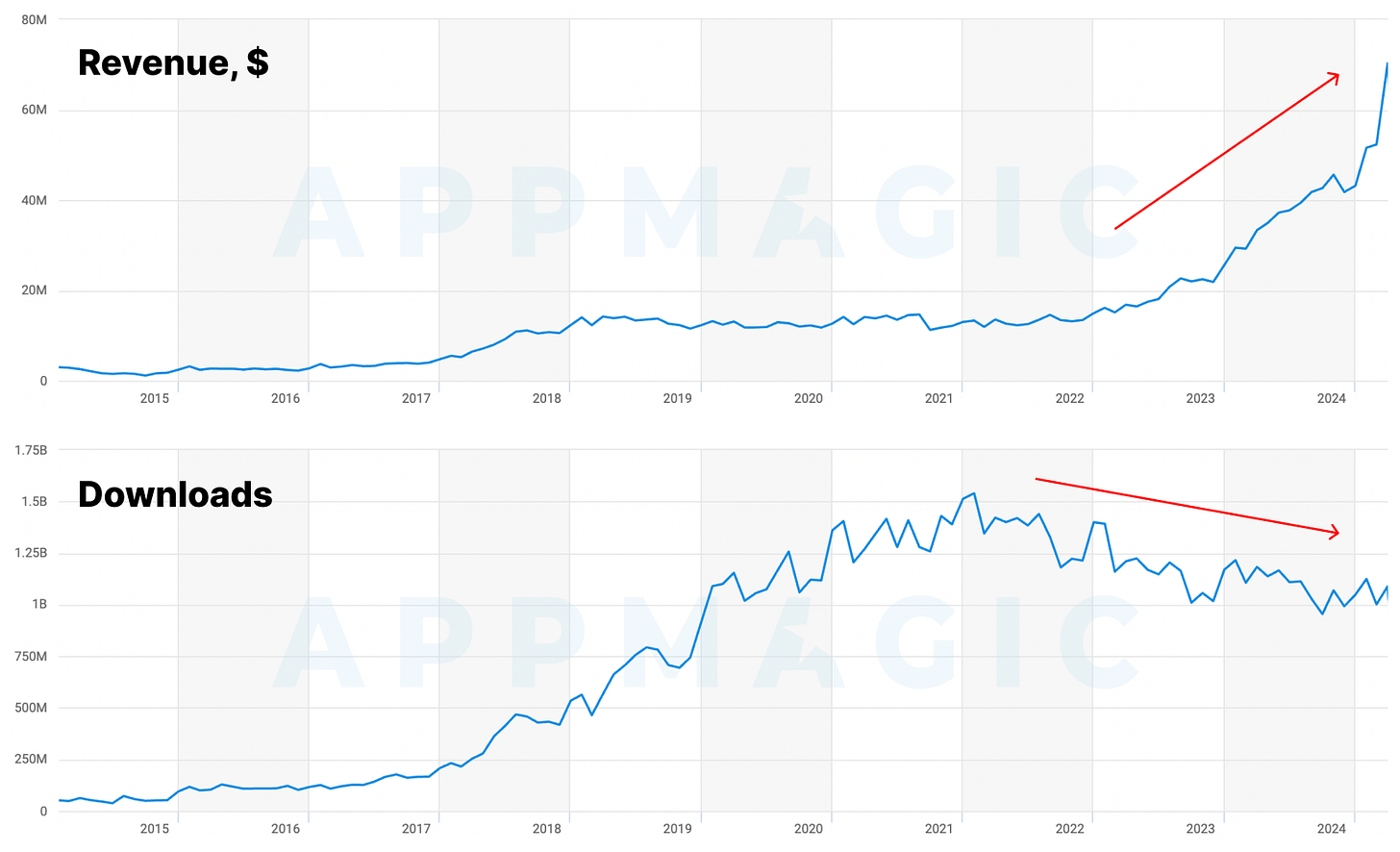🔍 On Product Velocity
Data: Shift from hypercasual to hybridcasual, IAP Rev +67% YOY
Hey Folks,
I've decided to retire the GameOver/Hot Takes segment. While it was enjoyable at first, I've concluded it's no longer worth the investment of my time. Ultimately, I want to ensure that the content I produce is valuable—not only to you as readers but also to me personally.
One of my goals is to eventually write a book. So, starting now, I'll dedicate Fridays to sharing various lessons and insights I encounter. These will likely be quick-hit posts that I jot down some initial thoughts about.
However, with over 21K subscribers and around 12K regular reads, the newsletter data provides valuable insights into trends and topics that I can use to gauge community interest.
I’ll also keep some other segments from GameOver, like news (but fewer items), data, and maybe WTF (at least sometimes).
So, welcome to this new segment! Let's see how it goes—I hope you'll find it insightful and helpful.
Check it out below!
Product Velocity: Direction + Optimizing Iteration Cycles
Speed has long been considered one of the most important characteristics of successful startups and new game development projects.
Every investor and executive will tell you that speed is everything. However, I believe the general view of the importance of “speed” lacks specific nuance in two critical ways.
1. Product Velocity
Velocity is a vector with both magnitude (speed) and direction. This distinction is crucial in product development. Speed, while critical, isn’t enough. Teams must move fast and in the right direction.
In a gaming context, product velocity can be thought of as needing to get both the micro (speed/execution) and macro (direction) right.
Micro associates with the quality of the team leads (CEO, tech lead, creative director, etc.) and the team itself, the specific work processes and practices, the workflows, and the attitude and culture of the team.
Macro can be simplified to mean a team’s product strategy. This includes aligning against key environmental factors and trends, differentiation in the market, and how well a product delivers against critical bases of competition.
To make the macro a bit more specific for game development, it would include things like the kind of game to make, the development approach or philosophy, the operational and team model (hybrid, remote, in-office), geographic strategy, recruiting and hiring strategy, and other such things.
2. Characterizing Your Product Iteration Cycle
How do you improve speed?
Too often, we may adopt the simplistic view that speed improves only through hard work and effort. While the impact of hard work on speed may be true, the nuance here is that effort isn’t enough.
Speed critically depends on the design of a workflow. Hence, teams should also consider improving and optimizing their workflows to improve speed.
Two important steps to improve workflow:
Characterize and evaluate your product iteration cycle
Carefully analyze and deeply think about how to improve
1. Characterize & Evaluate
Map your iteration cycle. Characterize and break down each step. Find the bottlenecks. Fix them.
Think of it as a machine whose inputs, outputs, and process steps can be analyzed and improved.
A simple view of a typical product iteration cycle may look like the following:
2. Analyze & Deep Think
Too many teams keep “turning the crank” without carefully evaluating and analyzing how they work.
Teams need to consider more carefully:
Where are we getting stuck?
What can we do better?
*Who* are we getting blocked on? Can someone else do better?
Think from first principles: How would we design our work if we were to zero base the workflow?
What is the root cause of process steps that take a long time?
Who vs. What
When analyzing and deep thinking about the workflow, teams should also remember to consider not only the what but also the who. Often, the problem may not be the process or practice but the specific person doing the work. Many times, calling out a person is politically problematic. However, to fix a problem, you will need to actually fix the problem.
This means you may need to replace someone to improve speed, regardless of how emotionally or politically difficult it may be.
Reducing Iteration
Product development generally requires many rounds of iteration to achieve product-market fit.
Hence, reducing the number of product iteration cycles is also a major contributor to speeding up. Teams should, therefore, carefully consider how product design changes are being made and how the quality of iteration decisions can improve.
Pivots May Be Necessary
One final note on iteration: During analysis and deep thinking, a team may conclude that the product direction is wrong. There should be some time to carefully consider the direction on a regular basis.
In short, re-evaluating direction should be part of the iteration cycle. Through iteration, a team may discover a new, much better global maxima of opportunity relative to a local maxima they are currently pursuing.
Improving Product Velocity Cheat Sheet
Characterize and Identify Your Bottlenecks
Which process step causes the most delay?
Where does work pile up? Which handoffs cause delays? Where, VERY specifically?
What decisions are being made incorrectly, with too many stakeholders, or a bad process?
Measure Your Cycle Time
Track time from iteration start to live deployment
Break down time spent in each phase
Identify which types of changes move fastest
Optimize Systematically
Remove blockers or unnecessary steps or approvals
Parallelize where possible
Remove or change the people that cause delays
Analyze Carefully and Think Deeply
Deploy root cause analysis and decision analysis to help determine problems & solutions
Be brutally honest on required changes
Thought experiment: If your mom’s life depended on you getting this right, what would you do?
Real World Context
Recently, many game studios have unsuccessfully tried making extraction shooter games. Some of the world’s most skilled game studios, like the Tencent Timi and Netease teams, have tried many times and failed here.
There are many, many dead bodies in extraction.
Our studio started before them, but we’ve been stuck in development hell for over four years. Our execution was so bad that we were too slow to fail fast. We’re still here, while most others have already started, launched, failed, and given up.
In short, we have sucked at speed. We’ve been slowly improving, but not quite there yet. To be clear, I believe speed is critically important for success, and we’re working on it.
My insights on this topic are drawn from getting punched in the face over and over again.
However, if we succeed, it will be due to our direction, which differentiates more strongly than previous attempts. We're still working on our speed, but at least now we know where to look. Our story is still being written.
IAP growth of the “hypercasual” market:
Post IDFA deprecation, hypercasual games have struggled as CPMs have declined. Survival goes to those that are best able to adapt and adjust to the new environment by shifting from pure IAA to hybrid IAA and IAP.
The top 10 hybridcasual games have increased IAP revenue by 67% to $87M in net revenue by Q1 2025:
Top 3 Gaming News
Unity: New AI Ad Platform 'Vector' Shows Strong Early Results (Unity Earnings Call – May 2025): Unity’s new AI ad platform, Vector, is live across all iOS and Android traffic and is already delivering 15–20% gains in installs and IAP value on iOS. Management says the platform’s real-time learning models are just starting and expects stronger ad revenue growth ahead.
Fortnite Mobile Returns to iOS in the U.S. (Polygon): Epic Games is returning Fortnite to the U.S. iOS App Store for the first time since its 2020 removal. Using its Sweden-based developer account, Epic expects approval between May 10–15, with full crossplay and 20% Epic Rewards for direct purchases.
EA Declares Post-Layoff Strategy Will Drive 'Accelerated Growth' (Game Developer): Following recent layoffs and project cancellations, EA states it is now positioned for "accelerated growth," focusing on fewer, high-impact titles. The company aims to streamline operations and concentrate resources on its most promising franchises.
Top 3 AI x Gaming News
Level-5 CEO States 80–90% of Game Code Now AI-Generated (Automaton Media): Level-5's CEO revealed that AI now handles most of their game coding, underscoring the importance of developers' aesthetic judgment in the AI-driven development process.
AI: The Extinction-Level Event for Game Dev Jobs? (GameMakers):
GOAT Gaming CEO Simon Davis warns that AI could wipe out many game development jobs, from concept art to scripting. In this GameMakers interview, he compares AI’s impact to past disruptions like mobile and F2P—but potentially bigger. Davis urges studios to adopt AI now or risk irrelevance.EA CEO Highlights AI's Role Post-Layoffs (GamesRadar): Following significant layoffs, EA's CEO emphasized AI's growing role in design, animation, and storytelling, positioning it as a key driver for future creativity and innovation.













I think an interesting discussion would be around where does early monetization x UA efficiency fit within a product roadmap. Often times game teams have to keep the lights on by catering to elder users, have limited resources, and usually sacrifice new user improvements since they dont really affect the bulk of the revenue generation.
As a marketer, often times I wish there were dedicated product managers who's sole goal is to help improve new user monetization and retention. From a marketing perspective, publishing teams are often very hands off in the creation of new user monetization and typically amplify existing new user monetization signals.